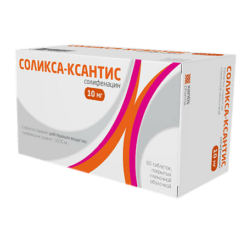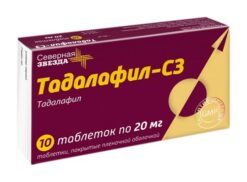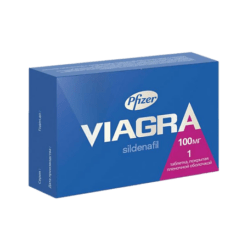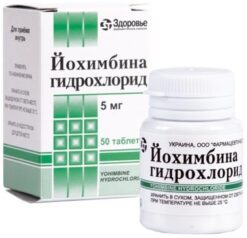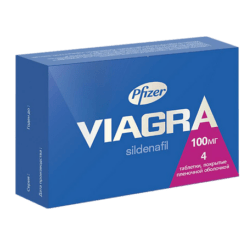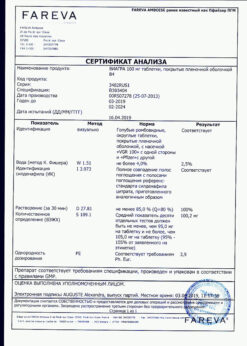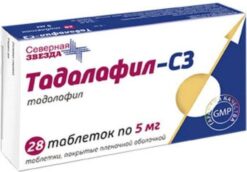No products in the cart.
Solixa Xanthis, 10 mg 30 pcs
€20.70 €17.94
Description
Pharmacotherapeutic group:Medications for frequent urination and incontinence, antispasmodic.
ATH CODE: G04BD08
Pharmacological properties
Mechanism of action
/em>
Solifenacin is a specific competitive muscarinic receptor antagonist. The bladder is innervated by parasympathetic cholinergic nerves. Acetylcholine acts on muscarinic receptors (predominantly M3) and causes detrusor contraction. Pharmacological studies conducted
in vitro and in vivo have shown that solifenacin is a specific competitive inhibitor of muscarinic subtype M3 receptors. Solifenacin was also found to have low or no affinity for various other receptors and ion channels.
Pharmacodynamics
The clinical effects of solifenacin at doses of 5 mg and 10 mg are observed during the first week of treatment and stabilize over the following 12 weeks of treatment. Efficacy lasts for at least 12 months. The maximum effect of solifenacin is observed 4 weeks after the start of therapy.
Pharmacokinetics
Absorption:The maximum plasma concentration (Cmax) is reached after 3-8 hours. Time to reach maximum concentration (Tmax) is independent of dose. Cmax and the area under the curve (AUC) of concentration versus time increase in proportion to the dose from 5 to 40 mg. Absolute bioavailability is 90%. Food intake has no effect on the Cmax and AUC of solifenacin.
Distribution:The volume of distribution of solifenacin after intravenous administration is approximately 600 L. Solifenacin is largely (about 98%) bound to plasma proteins, predominantly to α1-acid glycoprotein.
Metabolism: Solifenacin is actively metabolized by the liver, mainly by CYP3A4 isoenzyme. However, there are alternative metabolic pathways through which solifenacin may be metabolized. Systemic clearance of solifenacin is about 9.5 l/hour, and the terminal elimination half-life is 45-68 hours. After oral administration the following metabolites were identified in plasma in addition to solifenacin: one pharmacologically active
(4R-hydroxysolifenacin) and three inactive (N-glucuronide, N-oxide and 4R-hydroxy-
N-oxide solifenacin).
Elimation: After a single administration of 10 mg 14C-labeled solifenacin after
26 days, about 70% radioactivity was detected in urine and 23% in feces. In urine, approximately 11% of radioactivity was found as unchanged active ingredient, approximately 18% as N-oxide metabolite, 9% as 4R-hydroxy-N-oxide metabolite, and 8% as 4R-hydroxy metabolite (active metabolite). The pharmacokinetics of solifenacin are linear over the therapeutic dose range.
Peculiarities of pharmacokinetics in selected categories of patients
Age:There is no need to adjust the dose according to the age of the patient. Studies have shown that exposure to solifenacin (5 and 10 mg), expressed as AUC, was similar in healthy older volunteers (65 to 80 years) and in healthy younger volunteers (<55 years).
The mean absorption rate, expressed as Tmax, was slightly lower and the final half-life was approximately 20% longer in older subjects. These minor differences are not clinically significant.
The pharmacokinetics of solifenacin have not been determined in children and adolescents.
Gender: The pharmacokinetics of solifenacin are independent of patient gender.
Race: Race has no effect on the pharmacokinetics of solifenacin.
Renal impairment: AUC and Cmax of solifenacin in patients with mild to moderate renal impairment are not significantly different from those in healthy volunteers. In patients with severe renal failure (creatinine clearance < 30 ml/min) solifenacin exposure is significantly higher – increase in Cmax is about 30%, AUC – over 100% and
T1/2 – over 60%. There is a statistically significant relationship between creatinine clearance and solifenacin clearance. Pharmacokinetics in patients undergoing hemodialysis have not been studied.
Hepatic failure: In patients with moderate hepatic impairment (Child-Pugh stage B), Cmax is unchanged, AUC is increased by 60%, T1/2 is doubled. Pharmacokinetics in patients with severe hepatic impairment have not been determined.
Indications
Indications
Symptomatic treatment of urinary incontinence, frequent urination and urinary urgency in patients with overactive bladder syndrome.
Pharmacological effect
Pharmacological effect
Pharmacotherapeutic group: drugs for the treatment of frequent urination and urinary incontinence, antispasmodic.
ATX CODE: G04BD08
Pharmacological properties
Mechanism of action
Solifenacin is a specific competitive antagonist of muscarinic receptors. The bladder is innervated by parasympathetic cholinergic nerves. Acetylcholine acts on muscarinic receptors (mainly M3) and causes detrusor contraction. Pharmacological studies conducted
in vitro and in vivo, showed that solifenacin is a specific competitive inhibitor of muscarinic receptors of the M3 subtype. Solifenacin has also been found to have low or no affinity for various other receptors and ion channels.
Pharmacodynamics
The clinical effect of solifenacin in doses of 5 mg and 10 mg is observed already during the first week of treatment and stabilizes over the next 12 weeks of treatment. Effectiveness lasts for at least 12 months. The maximum effect of solifenacin is observed 4 weeks after the start of therapy.
Pharmacokinetics
Absorption: maximum plasma concentration (Cmax) is reached after 3-8 hours. The time to reach maximum concentration (Tmax) is independent of dose. Cmax and area under the curve (AUC) of concentration versus time increase in proportion to increasing doses from 5 to 40 mg. Absolute bioavailability – 90%. Food intake does not affect the Cmax and AUC of solifenacin.
Distribution: The volume of distribution of solifenacin after intravenous administration is approximately 600 L. Solifenacin is highly (about 98%) bound to plasma proteins, predominantly to α1-acid glycoprotein.
Metabolism: solifenacin is extensively metabolized by the liver, predominantly by the CYP3A4 isoenzyme. However, there are alternative metabolic pathways through which solifenacin can be metabolized. The systemic clearance of solifenacin is approximately 9.5 L/hour, and the terminal half-life is 45-68 hours. After oral administration of the drug in plasma, in addition to solifenacin, the following metabolites were identified: one pharmacologically active
(4R-hydroxysolifenacin) and three inactive ones (N-glucuronide, N-oxide and 4R-hydroxy-
Solifenacin N-oxide).
Elimination: after a single administration of 10 mg of 14C-labeled solifenacin after
After 26 days, about 70% of the radioactivity was detected in urine and 23% in feces. In urine, approximately 11% of the radioactivity was found as unchanged active substance, about 18% as the N-oxide metabolite, 9% as the 4R-hydroxy-N-oxide metabolite, and 8% as the 4R-hydroxy metabolite (the active metabolite). The pharmacokinetics of solifenacin is linear over the therapeutic dose range.
Features of pharmacokinetics in certain categories of patients
Age: There is no need to adjust the dose depending on the patient’s age. Studies have shown that solifenacin (5 and 10 mg) exposure, expressed as AUC, was similar in healthy elderly volunteers (65 to 80 years) and healthy young volunteers (<55 years).
The mean absorption rate, expressed as Tmax, was slightly lower and the terminal half-life approximately 20% longer in older adults. These minor differences are not clinically significant.
The pharmacokinetics of solifenacin have not been determined in children and adolescents.
Gender: The pharmacokinetics of solifenacin does not depend on the gender of the patient.
Race: Race does not affect the pharmacokinetics of solifenacin.
Renal failure: The AUC and Cmax of solifenacin in patients with mild to moderate renal failure are not significantly different from the corresponding values in healthy volunteers. In patients with severe renal failure (creatinine clearance <30 ml/min), the exposure to solifenacin is significantly higher - the increase in Cmax is about 30%, AUC is more than 100% and
T1/2 – more than 60%. There was a statistically significant relationship between creatinine clearance and solifenacin clearance. Pharmacokinetics in patients undergoing hemodialysis have not been studied.
Liver failure: In patients with moderate liver failure (stage B according to the Child-Pugh classification), the Cmax value does not change, AUC increases by 60%, T1/2 doubles. Pharmacokinetics in patients with severe hepatic impairment have not been determined.
Special instructions
Special instructions
QT prolongation and torsade de pointes (TdP) have been observed in patients with risk factors such as existing QT prolongation and hypokalemia. Efficacy and safety have not been studied in patients with neurogenic bladder dysfunction. Several cases of angioedema with airway obstruction have been identified in patients taking solifenacin. Therefore, if angioedema occurs, solifenacin should be discontinued and appropriate measures taken.
Several cases of anaphylactic reactions have been identified in patients taking solifenacin. Therefore, if an anaphylactic reaction occurs, solifenacin should be discontinued and appropriate measures taken.
Influence on the ability to drive vehicles and machinery
Solifenacin, like other anticholinergic drugs, may cause blurred vision and (rarely) drowsiness and fatigue, which may impair the ability to drive and operate machines.
Active ingredient
Active ingredient
Solifenacin
Composition
Composition
1 film-coated tablet, 10 mg contains:
active ingredient:
solifenacin succinate – 10.00 mg;
excipients:
lactose monohydrate – 110.50 mg,
corn starch – 30.00 mg,
talc – 3.00 mg,
magnesium stearate – 1.50 mg;
film coating: opadry white 03B28796 – 3.60 mg, (hypromellose 6cP E464 – 2.2500 mg, titanium dioxide E171 – 1.1250 mg, macrogol 400 – 0.2250 mg), opadry brown 02F 23883 – 0.40 mg (hypromellose 5 cP E464 – 0.2374 mg, titanium dioxide E171 – 0.0895 mg, macrogol 6000 – 0.0475 mg, yellow iron oxide dye E172 – 0.0128 mg, red iron oxide dye E172 – 0.0128).
Pregnancy
Pregnancy
There are no clinical data on women who became pregnant while taking solifenacin. Animal studies have shown no direct adverse effects on fertility, embryonic/fetal development or childbirth. Solifenacin can be used during pregnancy only if the benefit of therapy for the mother outweighs the potential risk to the fetus.
There is no data on the penetration of solifenacin into human breast milk. In animal studies, it was found that solifenacin and/or its metabolites were excreted into the milk of lactating mice. The use of solifenacin is contraindicated during breastfeeding.
Contraindications
Contraindications
urinary retention;
severe gastrointestinal diseases (including toxic megacolon);
myasthenia gravis;
angle-closure glaucoma;
hypersensitivity to solifenacin or any of the excipients;
hemodialysis;
severe liver failure;
severe renal failure or moderate liver failure during simultaneous treatment with strong inhibitors of the CYP3A4 isoenzyme, such as ketoconazole (see section “Interaction with other drugs”);
lactase deficiency, lactose intolerance, glucose-galactose malabsorption syndrome;
breastfeeding period (see section “Use during pregnancy and breastfeeding”)
children under 18 years of age.
With caution
Before starting solifenacin therapy, other causes of frequent urination (chronic heart failure or kidney disease) should be excluded. If a urinary tract infection is detected, appropriate antibiotic therapy should be administered. Compliance with precautions when using solifenacin is required in patients:
with clinically significant obstruction of the bladder outlet, leading to the risk of developing urinary retention;
with gastrointestinal diseases with obstruction;
with a risk of reduced gastrointestinal motility;
with severe renal failure (creatinine clearance <30 ml per minute) and moderate liver failure (Child-Pugh stage B); Doses for these patients should not exceed 5 mg;
while taking a strong inhibitor of the CYP3A4 isoenzyme, for example, ketoconazole;
with a hiatal hernia, gastroesophageal reflux, or patients concomitantly taking medications (for example, bisphosphonates) that can cause or worsen esophagitis;
with autonomic neuropathy;
in women during pregnancy (see section “Use during pregnancy and breastfeeding”).
Side Effects
Side Effects
The use of solifenacin may cause adverse reactions associated with its anticholinergic effect, often of mild or moderate severity. The frequency of these adverse reactions depends on the dose of solifenacin. The most commonly reported adverse reaction of solifenacin is dry mouth. It was observed in 11% of patients receiving a dose of 5 mg per day, in 22% of patients receiving a dose of 10 mg per day, and in 4% receiving placebo. The severity of dry mouth was usually mild and only in rare cases led to treatment interruption.
Immune system disorders: anaphylactic reactions
Metabolic and nutritional disorders: loss of appetite, hyperkalemia
Mental disorders: hallucinations, confusion, delirium
Gastrointestinal disorders: dry mouth, constipation, nausea, dyspepsia, abdominal pain, gastroesophageal reflux disease, dry pharynx, colonic obstruction, coprostasis, vomiting, ileus, abdominal discomfort
Disorders of the liver and biliary tract: liver dysfunction, changes in liver function tests
Infectious and parasitic diseases: urinary tract infection, cystitis
Nervous system disorders: drowsiness, dysgeusia (taste disturbance), dizziness, headache
Visual disorders: blurred vision (impaired accommodation), dry mucous membrane of the eyes, glaucoma
Cardiac disorders: ventricular tachycardia of the “pirouette” type, prolongation of the QT interval (ECG), atrial fibrillation, tachycardia, palpitations
General disorders and administration site disorders: fatigue, peripheral edema
Disorders of the respiratory system, chest and mediastinal organs: dry nasal cavity, dysphonia
Skin and subcutaneous tissue disorders: dry skin, rash, itching, erythema multiforme, urticaria, angioedema, exfoliative dermatitis
Musculoskeletal and connective tissue disorders: muscle weakness
Renal and urinary tract disorders: difficulty urinating, urinary retention, renal failure
Interaction
Interaction
Pharmacological interaction
Concomitant treatment with drugs with anticholinergic properties may lead to more pronounced pharmacological effects and adverse reactions. After stopping solifenacin, take approximately a week off before starting treatment with another anticholinergic drug. The pharmacological effect may be reduced by concomitant use of cholinergic receptor agonists. Solifenacin may reduce the effect of drugs that stimulate gastrointestinal motility, such as metoclopramide.
Pharmacokinetic interaction
In vitro studies have shown that at therapeutic concentrations solifenacin does not inhibit the isoenzymes CYP1A1/2, 2C9, 2C19, 2D6 or ZA4 isolated from human liver microsomes. Therefore, solifenacin is unlikely to alter the clearance of drugs metabolized by these CYP enzymes.
Effect of other drugs on the pharmacokinetics of solifenacin
Solifenacin is metabolized by the CYP3A4 isoenzyme. Co-administration of ketoconazole (200 mg per day), a strong inhibitor of the CYP3A4 isoenzyme, caused a two-fold increase in the AUC of the concentration-time dependence of solifenacin, and at a dose of 400 mg/day – a three-fold increase. Therefore, the maximum dose of solifenacin should not exceed 5 mg if the patient is concomitantly taking ketoconazole or therapeutic doses of other strong CYP3A4 inhibitors (such as ritonavir, nelfinavir, itraconazole). The combined use of solifenacin and strong inhibitors of the CYP3A4 isoenzyme is contraindicated in patients with severe renal impairment or moderate hepatic impairment. The phenomena of enzyme induction on the pharmacokinetics of solifenacin and its metabolites, as well as the influence of high-affinity substrates of the CYP3A4 isoenzyme on the action of solifenacin, have not been studied.
Since solifenacin is metabolized by the CYP3A4 isoenzyme, pharmacokinetic interactions with other CYP3A4 isoenzyme substrates with higher affinity (verapamil, diltiazem) and with CYP3A4 isoenzyme inducers (rifampicin, phenytoin, carbamazepine) are possible.
Effect of solifenacin on the pharmacokinetics of other drugs
Oral contraceptives: no pharmacokinetic interaction has been identified between solifenacin and combined oral contraceptives (ethinyl estradiol + levonorgestrel).
Warfarin: Solifenacin did not cause changes in the pharmacokinetics of R-warfarin or S-warfarin or their effect on prothrombin time.
Digoxin: Solifenacin had no effect on the pharmacokinetics of digoxin.
Overdose
Overdose
Overdose of solifenacin can potentially lead to severe anticholinergic effects. The highest dose of solifenacin that was accidentally taken by one patient was 280 mg over 5 hours. This dose resulted in a change in the patient’s mental status but did not require hospitalization. In cases of overdose, activated charcoal should be prescribed, gastric lavage is effective for an hour, but vomiting should not be induced. As with overdose of other anticholinergic drugs, symptoms should be treated as follows:
for severe anticholinergic effects of central action (hallucinations, severe excitability) – carbachol;
for convulsions or severe excitability – benzodiazepines;
in case of respiratory failure – artificial respiration;
for tachycardia – beta blockers;
for acute urinary retention – catheterization;
for mydriasis, instill pilocarpine into the eyes and/or place the patient in a dark room.
As with overdose of other anticholinergic drugs, special attention should be paid to patients with an established risk of QT prolongation (i.e., hypokalemia, bradycardia, and concomitant use of drugs known to prolong the QT interval) and patients with previously diagnosed cardiac disease (myocardial ischemia, arrhythmias, chronic heart failure).
Storage conditions
Storage conditions
At a temperature not exceeding 25 °C.
Keep out of the reach of children.
Shelf life
Shelf life
4 years.
Do not use after expiration date.
Manufacturer
Manufacturer
Saneka Pharmaceuticals a.s., Slovakia
Additional information
| Shelf life | 4 years. Do not use after the expiration date. |
|---|---|
| Conditions of storage | At a temperature not higher than 25 ° C. Keep out of reach of children. |
| Manufacturer | Saneka Pharmaceuticals a.s., Slovakia |
| Medication form | pills |
| Brand | Saneka Pharmaceuticals a.s. |
Other forms…
Related products
Buy Solixa Xanthis, 10 mg 30 pcs with delivery to USA, UK, Europe and over 120 other countries.


